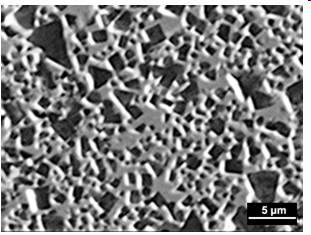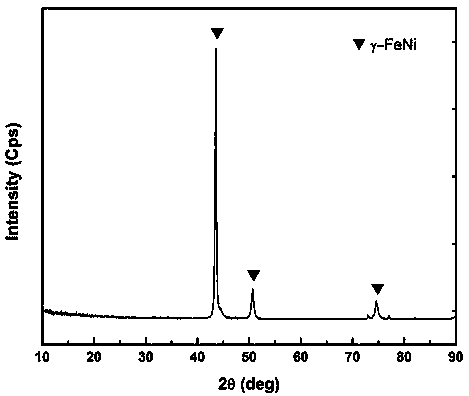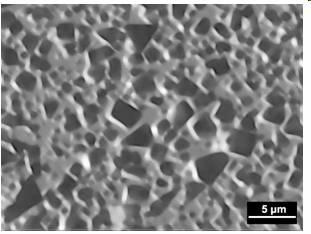Chemical corrosion method for removing hard phases on surface of hard alloys
A cemented carbide and chemical corrosion technology, applied in the field of cemented carbide, can solve the problems of easy-to-corrosion WC corrosion binder phase, difficult control of electrolytic parameters, quantitative measurement errors, etc., to achieve convenient preparation, easy popularization and application, and high accuracy Effect
- Summary
- Abstract
- Description
- Claims
- Application Information
AI Technical Summary
Problems solved by technology
Method used
Image
Examples
Embodiment 1
[0036] A chemical corrosion method for removing the hard phase on the surface of the cemented carbide. In this embodiment, a WC-Fe-Ni cemented carbide with a binder phase content of 10 wt.% is selected, and the steps are as follows:
[0037] (1) Use 180#, 400#, 800#, 1000#, 2000# diamond grinding discs to polish on the polishing machine, and then use 0.5μm diamond polishing paste to polish the cemented carbide surface into a mirror surface, and then clean it with water , Blow dry;
[0038] (2) Dissolve 1.0 g potassium ferricyanide and 15.2 g sodium hydroxide per 100 mL of distilled water, mix and stir to prepare the corrosive solution, ready to use; put the polished cemented carbide into the corroded Immediately proceed to the next step in the liquid;
[0039] (3) Ultrasonic vibration treatment for 20 minutes;
[0040] (4) Turn off the ultrasound and let it stand for 130min at room temperature in a shading environment;
[0041] (5) Repeat steps (3) and (4) 4 times;
[0042] (6) Remove ...
Embodiment 2
[0045] A chemical corrosion method for removing the hard phase on the surface of cemented carbide. In this embodiment, a WC-Fe-Ni cemented carbide with a binder phase content of 20 wt.% is selected, and the steps are as follows:
[0046] (1) Use 180#, 400#, 800#, 1000#, 2000# diamond grinding discs to polish on the polishing machine, and then use 0.5μm diamond polishing paste to polish the cemented carbide surface into a mirror surface, and then clean it with water , Blow dry;
[0047] (2) Dissolve 0.8 g potassium ferricyanide and 10.2 g sodium hydroxide per 100 mL of distilled water, mix and stir to prepare the corrosive solution, ready to use; put the polished cemented carbide into the corroded Immediately proceed to the next step in the liquid;
[0048] (3) Ultrasonic vibration treatment for 15 minutes;
[0049] (4) Turn off the ultrasound and let it stand for 105min at room temperature in a shading environment;
[0050] (5) Repeat steps (3) and (4) 4 times;
[0051] (6) Remove the ...
Embodiment 3
[0054] A chemical corrosion method for removing the hard phase on the surface of the cemented carbide. In this embodiment, a WC-Fe-Ni cemented carbide with a binder phase content of 30wt.% is selected, and the steps are as follows:
[0055] (1) Use 180#, 400#, 800#, 1000#, 2000# diamond grinding discs to polish on the polishing machine, and then use 0.5μm diamond polishing paste to polish the cemented carbide surface into a mirror surface, and then clean it with water , Blow dry;
[0056] (2) Dissolve 0.4g potassium ferricyanide and 9.2g sodium hydroxide per 100 mL of distilled water, mix and stir to prepare the corrosive solution, ready to use; put the polished cemented carbide into the corrosion Immediately proceed to the next step in the liquid;
[0057] (3) Ultrasonic vibration treatment for 10 minutes;
[0058] (4) Turn off the ultrasound and let it stand for 90 minutes at room temperature in a shading environment;
[0059] (5) Repeat steps (3) and (4) 3 times;
[0060] (6) Remove...
PUM
| Property | Measurement | Unit |
|---|---|---|
| thickness | aaaaa | aaaaa |
Abstract
Description
Claims
Application Information
 Login to View More
Login to View More - R&D
- Intellectual Property
- Life Sciences
- Materials
- Tech Scout
- Unparalleled Data Quality
- Higher Quality Content
- 60% Fewer Hallucinations
Browse by: Latest US Patents, China's latest patents, Technical Efficacy Thesaurus, Application Domain, Technology Topic, Popular Technical Reports.
© 2025 PatSnap. All rights reserved.Legal|Privacy policy|Modern Slavery Act Transparency Statement|Sitemap|About US| Contact US: help@patsnap.com



